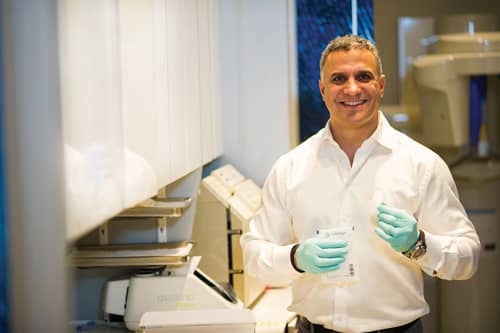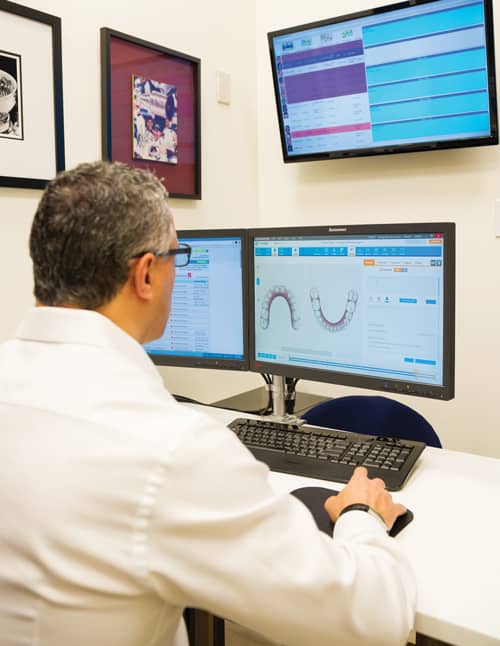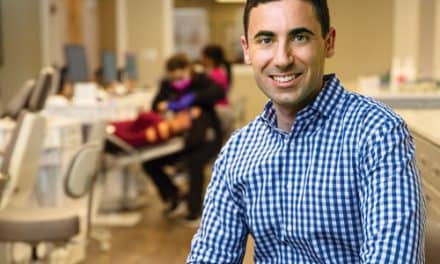In 1994, when Sam Daher, DDS, MSc, received his general dentistry degree from McGill University, Montréal, he had no ambitions of being a world-renowned name in orthodontics.
For 6 years I was a general dentist, doing orthodontics one day a week—on Mondays,” Daher recalls. “After some time, I found that Mondays were my happiest day of the week. It became the most gratifying part of my job.”
[sidebar float=”right” width=”225″]
Practice Profile
Practice name: Daher Orthostyle
Location: Two offices in Vancouver, three in Calgary, and one in Montréal
Number of chairs: 3 to 7
Years in practice: 22 years in total (including 6 as a general dentist)
Education: DDS from McGill University, Montréal; MSc and specialty in orthodontics from the Université de Montréal.
Average number of patients per day: 75
Days worked per month: 15 to 17 clinical; 10 travel and lecture/seminars
Top products used: Invisalign® (Align Technology Inc), SPEED brackets (SPEED System Orthodontics), AcceleDent® (OrthoAccel Technologies Inc)
Website: orthostyle.com [/sidebar]
In 2000, Daher decided to go back to school and specialize in orthodontics, but in a slightly different way than most. “I attended the Université of Montréal and completed my degree entirely in French,” he notes. “Orthodontics is easy in English, so I thought to myself, ‘Let’s make it a bit more challenging and do it in French.’”
By 2003, Daher purchased his first orthodontic practice in Vancouver—later branded Daher Orthostyle—and set to work turning each day into his favorite one of the week. “Of the specialties in dentistry, orthodontics is the most rewarding,” he explains. “It’s a pleasant experience for both me and the patient. And seeing that nice smile in the end, nothing beats that.”
Over the course of several years, Daher grew his practice to include six locations in Vancouver, British Columbia; Calgary, Alberta; and Montréal, Québec.
From the beginning, Daher has had what many would consider an unconventional practice. For starters, he primarily treats adults. More specifically, 70% of his patients are women between the ages of 25 and 45.
“That generation and demographic is a bit more health-oriented and aesthetically inclined,” Daher explains. “Around the time I purchased my first practice, Invisalign® (Align Technology Inc) was just being introduced. My adult patients were in a period of life where they had more disposable income and were interested in having their teeth straightened if they could do it without wearing braces.”
As can be expected, Daher soon realized that treating adults was a bit different compared to treating teens. He had to work around issues such as missing teeth, implants, crowns, and bridges. What’s more, with teens, their bodies are still growing, and, as Daher points out, the younger set typically has better oral hygiene practices that are enforced by their parents.
“Once I was able to master working with adults, word of mouth spread and more and more grown men and women came to see me about treatment,” he recalls. “That’s really how my first practice became a success.”
Daher grew his practice based on treating a niche of patients who, for years prior, were not a focus for orthodontists. And, as technology evolved, he very quickly learned that there were other, more innovative ways to treat his very specific patient base.
 An Innovative Approach
An Innovative Approach
Unconventional would be a very good choice of words to describe Daher and his career. As stated on the website of Daher Orthostyle, he and his staff “offer customized orthodontic treatment, designed to take into consideration a patient’s lifestyle and aesthetic preferences.”
This cornerstone of his work philosophy is based solely on his experiences while studying to be an orthodontist.
“I remember when I was a student in graduate school, all these patients would walk out with the exact same smile, the exact same width, the exact same alignment,” Daher recalls. “They all looked alike because we, as orthodontists, used the same wire and the same braces and the same techniques.”
[sidebar float=”right” width=”250″]
The “In(line)” Crowd
Sam Daher, DDS, MSc, of Daher Orthostyle, Vancouver, is an advocate for orthodontics education—to both his peers and patients. He’s spoken to tens of thousands of doctors around the globe, spending nearly 6 months per year collaborating with colleagues on behalf of advancements in orthodontic treatment today.
But, in a sense, it all started in 2005 when Daher was approached by a musical icon who learned he was the go-to orthodontist for adults.
“Without mentioning names, we treated this particular person with Invisalign, and her agent told others, and before we knew it, we had an influx of celebrities flying to Vancouver to have Invisalign treatment done at our little office,” Daher recalls. “I was unheard of at the time, but these people had careers where their appearance was on the line. Therefore, flying every 3 months to Vancouver for orthodontic treatment wasn’t a big deal for them.”
Daher credits his first celebrity encounter to the amount of information he provides patients, especially those who are curious about orthodontic treatment. “We make it a point to educate our patients—either through our website or in person—as to what can be done, what should be done, and what to expect before and after treatment,” he says. “It all comes down to educating people at a distance.”
Daher explains that with this professional philosophy toward education, he’s had patients who have flown in from Shanghai, Hollywood, Boston, Australia, and further around the globe, because they were educated on what to expect when they arrived in his office.
Although he spends a third of his professional career speaking on behalf of Invisalign and AcceleDent, Daher is quite adamant about his stance on not being a mouthpiece for either technology, but instead a launching pad for thought on what can be done with these systems on an individual, patient-by-patient basis.
“I don’t make any money offering [AcceleDent] treatment in my practices. I sell it at cost,” he notes. “That’s important because it doesn’t affect my treatment plan. I’m not a salesman. I want to capture the patient motivation for the first 14 months. The most important thing I stress in my talks is that, first, orthodontists should try these systems. And, second, not every patient is going to accept it. However, it’s worked very well for me to give patients the option.” OP[/sidebar]
The concept of mass sameness didn’t sit well with Daher. He didn’t like the idea of—as he refers to it—a “fake smile.” Therefore, he began to conceptualize ways to provide customized treatment for the patients he treated.
“I realized then that I wanted to custom-fit the person’s smile with their face,” he notes. “Someone with an elongated face may have a smile that is a little bit different than the smile of someone who has a square face,” he explains. “The width of smile should be different, as should the smile line.
“As orthodontists, it’s our job to take a person’s own smile and make it better. Make it healthier. Make it nicer,” Daher adds. “It’s not in our best interest, or the patient’s, to change the face of the smile too much.”
Thus, Daher embarked on a path to innovation. He delved into learning about the game-changing technologies available at the time, and how to apply them toward the way he wanted to practice orthodontics.
He notes that his was the first orthodontic practice in Canada to adopt intraoral scanners for orthodontics. Early on, he identified the technology’s potential to be more pleasant for patients and more efficient for the bottom line of his business. Even in the beginning stages of intraoral scanners, many systems offered improved accuracy, as well as less distortion and rejections.
“Then and now, intraoral scanners enable me to modify my treatment plan based on the root position, which is very important,” Daher notes. “If I find that there is information regarding the bone, I may want to explore certain, more complex, orthodontic movements so as to achieve the results I want and make the process as pleasant as possible for the patient. This, and other technology, has really propelled the field of orthodontics forward.”
A Passionate Advocate
In 2008, Daher received a letter from Align Technology Inc stating that, according to their database statistics, Daher Orthostyle was the number-one provider of Invisalign in the world.
“It was never my goal to receive that title,” Daher recalls. “Most people think of large cities such as New York, Los Angeles, or Chicago as having the type of practice to use that much product; not a relatively small city like Vancouver with 1.2 million people.”
How Daher got to the top of the leader list for Invisalign goes back a few years prior, and has roots in his passion to individualize each smile and to stray from the norm.
“When I first saw the Invisalign technology, I was impressed with the possibilities of what it offered patients, particularly my patients,” he recalls. “From an oral care perspective, Invisalign was just easier. There would be less potential for staining, and patients could eat what they wanted, as long as they rinsed before putting the appliance back into their mouths. For adults, who drink and socialize with other adults in either a career or other setting, this was a viable factor for treatment.”
Daher also foresaw the usefulness of Invisalign in complicated treatment plans. “Sometimes, we’ll get a recession mid-treatment and a periodontist may need to place a graft. With braces, this is really difficult because they retain plaque and diminish the grafting procedure’s chance of success,” he explains. “With aligners, however, we simply pause treatment for 4 to 6 weeks and turn the aligners into what we call ‘retainers’ while the periodontist places the grafts.”

“The same goes for kids who play musical instruments,” Daher adds. “They can take the aligners out for an hour or two while they practice or perform.”
Although intrigued on behalf of his patients, Daher also was won over by the three-dimensional aspect of the Invisalign system. “There’s software, with a 3D model that we use to manipulate treatment by manipulating the teeth movement ourselves,” he notes. “For some reason, the first time I used the system, it stuck. I liked it; it made perfect sense to me.”
After Daher began treating patients with Invisalign, he garnered varied results from his varied patient base. “I found there were certain deficiencies to the system, so I realized I had to be creative,” he notes. “I started using elastics early on. To get the specific results I wanted, I cut the aligners, filed them, etc. The next thing I knew, I was getting crazy good results.”
Daher, his team, and his patients soon became advocates of Invisalign, and the system was a win-win for all. Since 2008, he has spoken about his creative tactics working with the system to more than 70,000 doctors worldwide, sharing both success stories and perils.
“The one thing I stress is that Invisalign is only a system. It’s only a piece of plastic,” he says. “It’s not about what we can do with it. Instead, it’s about how well we understand the biology of orthodontics. That makes the difference between a failure and a success.”
 Accelerating the Process
Accelerating the Process
After his Vancouver practice began to expand, Daher opened a satellite office in downtown Calgary. Shortly thereafter, a local orthodontist reached out to him with a professional offer.
“He said there were nine orthodontists in the city who were looking to try out this new technology called AcceleDent® from Houston-based OrthoAccel Technologies Inc. If I was willing to be the 10th to get on board and try it out, we could all go in together on 100 units—10 each—and get a great price for it,” Daher recalls. “I thought to myself that I’m new in town and I want to get on well with my new colleagues so I said, ‘Sure. Put me down for 10.’ I had no idea what I was buying.”
As Daher explains, 3 months later he was approached by the office manager in the Calgary office, wanting to know what should be done with the 10 boxes of AcceleDent devices that were collecting dust on the shelf.
“I said we paid for them, we might as well use them,” he says.
Based on the information the company provided about the technology, Daher decided to use his batch of 10 AcceleDent units to assist difficult malocclusions and those who were considered to have long-term treatment. What he found was that a typical 24-month treatment was reduced to 14 to 15 months.
“It was then that I realized, ‘You know what? There’s really something to this,’ so I started researching the science of this technology to find out what it was all about, and how it could be used to its best potential,” Daher recalls.
In his quest for knowledge, Daher reached out to a number of universities that had done studies on the technology, as well as to one of his most trusted resources—his brother, a physician in Montréal.
On all accounts, Daher became more enlightened with the technology and realized the potential for his patient base.
“As orthodontists, we all know patient compliance is at its best the first 12 months of treatment. After that, most lose interest, regardless whether they’re adults or kids,” Daher explains. “I thought that if I could get the AcceleDent in and turn a 2-year treatment into a 1-year or 14-month treatment, then I’ll get them done while they’re still interested and their compliance is still high. I won’t have to constantly remind them and motivate them about keeping on top of their responsibilities as a patient.”
In a number of ways, Daher’s willingness to go beyond the norm has enabled him to become a charismatic advocate for some of the most innovative technologies available in orthodontics today. He has spoken at over 300 conferences on six continents, has visited 30 US states, and has logged more than 1 million miles in the course of his career, speaking about what works and what doesn’t work in his practices and his profession.
“Technology has, for the most part, made our lives as orthodontists a lot better,” he says. “Speaking with colleagues and learning from each other is quite frankly the only way our profession is going to progress and survive. If I wanted to take all that I’ve learned to the grave with me, that would be a disservice to us all. Then, others would have to work to reinvent the wheel, which would be a terrible waste of time.” OP
Lori Sichtermann is a freelance writer for Orthodontic Products. She can be reached at [email protected].












